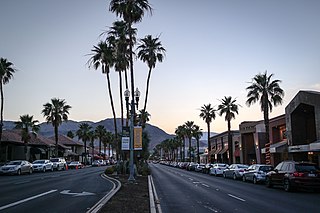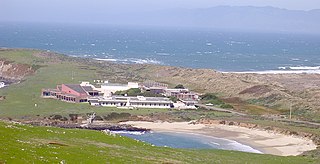
Palm Desert is a city in Riverside County, California, United States, in the Coachella Valley, approximately 14 miles (23 km) east of Palm Springs, 121 miles (195 km) northeast of San Diego and 122 miles (196 km) east of Los Angeles. The population was 48,445 at the 2010 census. The city has been one of the state's fastest growing since 1980, when its population was 11,801.

The Mojave Desert is a xeric desert in the rain shadow of the Sierra Nevada mountains in the Southwestern United States. It is named for the indigenous Mojave people. It is located primarily in southeastern California and southwestern Nevada, with small portions extending into Arizona and Utah.

The Sonoran Desert is a North American desert and ecoregion that covers large parts of the southwestern United States, as well as the northwestern Mexican states of Sonora, Baja California, and Baja California Sur. It is the hottest desert in both Mexico and the United States. It has an area of 260,000 square kilometers (100,000 sq mi).

The James San Jacinto Mountains Reserve, a unit of the University of California Natural Reserve System, is a 29-acre (120,000 m2) ecological reserve and biological field station located at an altitude of 5,200 feet (1,600 m) in a wilderness area of the San Jacinto Mountains near Lake Fulmor in Riverside County, California, United States.

Washingtonia filifera, the desert fan palm, California fan palm, or California palm, is a flowering plant in the palm family Arecaceae, native to the far southwestern United States and Baja California, Mexico. Growing to 15–20 m (49–66 ft) tall by 3–6 m (10–20 ft) broad, it is an evergreen monocot with a tree-like growth habit. It has a sturdy, columnar trunk and waxy, fan-shaped (palmate) leaves.

The Living Desert Zoo and Gardens, formerly the Living Desert Museum, is a non-profit zoo and desert botanical garden located in Palm Desert, Riverside County, California, United States. The Living Desert is home to over 500 animals representing over 150 species and welcomes over 500,000 visitors annually. Situated in the Sonoran Desert of the Coachella Valley and Santa Rosa Mountains foothills near Palm Springs, California, The Living Desert is set on 1,200 acres, with 80 developed as zoo and gardens.

The University of California Natural Reserve System (UCNRS) is a system of protected areas throughout California.

The Santa Rosa and San Jacinto Mountains National Monument is a National Monument in southern California. It includes portions of the Santa Rosa and San Jacinto mountain ranges, the northernmost ones of the Peninsular Ranges system. The national monument covers portions of Riverside County, west of the Coachella Valley, approximately 100 miles (160 km) southeast of downtown Los Angeles.

Opuntia engelmannii is a prickly pear common across the south-central and Southwestern United States and northern Mexico. It goes by a variety of common names, including desert prickly pear, discus prickly pear, Engelmann's prickly pear in the US, and nopal, abrojo, joconostle, and vela de coyote in Mexico.

Palm Springs is a desert resort city in Riverside County, California, United States, within the Colorado Desert's Coachella Valley. The city covers approximately 94 square miles (240 km2), making it the largest city in Riverside County by land area. With multiple plots in checkerboard pattern, more than 10% of the city is part of the Agua Caliente Band of Cahuilla Indians reservation land and is the administrative capital of the most populated reservation in California.

The Box Spring is a spring in Riverside County, California, around which grew the town of Box Springs. It is in the Moreno Valley, five miles (8.0 km) east-southeast of downtown Riverside on Interstate 215/State Route 60. Box Springs is named on the 7.5 quadrangle map, Riverside East (1967).

The Santa Rosa Wilderness is a 72,259-acre (292.42 km2) wilderness area in Southern California, in the Santa Rosa Mountains of Riverside and San Diego counties, California. It is in the Colorado Desert section of the Sonoran Desert, above the Coachella Valley and Lower Colorado River Valley regions in a Peninsular Range, between La Quinta to the north and Anza Borrego Desert State Park to the south. The United States Congress established the wilderness in 1984 with the passage of the California Wilderness Act, managed by both the US Forest Service and the Bureau of Land Management. In 2009, the Omnibus Public Land Management Act was signed into law which added more than 2,000 acres (8.1 km2). Most of the Santa Rosa Wilderness is within the Santa Rosa and San Jacinto Mountains National Monument.

Carl Eytel was a German American artist who built his reputation for paintings and drawings of desert subjects in the American Southwest. Immigrating to the United States in 1885, he settled in Palm Springs, California in 1903. With an extensive knowledge of the Sonoran Desert, Eytel traveled with author George Wharton James as he wrote the successful Wonders of the Colorado Desert, and contributed over 300 drawings to the 1908 work. While he enjoyed success as an artist, he lived as an ascetic and would die in poverty. Eytel's most important work, Desert Near Palm Springs, hangs in the History Room of the California State Library.
George Carlos Wheeler (1897–1991) was an entomologist who specialized in the study of ants.
Philip Linnaes Boyd was the first mayor of Palm Springs, California, a regent of the University of California and the namesake of the Deep Canyon Desert Research Center.
The Burns Piñon Ridge Reserve is a 303-acre nature reserve that is part of the University of California Natural Reserve System. It is located near Yucca Valley, California in San Bernardino County, California. Administered by UC Irvine, the reserve is owned by the University of California and managed for teaching and research.

Kenneth S. Norris Rancho Marino Reserve is part of the University of California Natural Reserve System. The reserve is located along the coast of San Luis Obispo County at the south end of the town of Cambria, California. It is named for Kenneth S. Norris, a University of California professor, renowned naturalist, and founder of the UC Natural Reserve System. It is operated by the university under a use agreement, as it is privately owned and funded. There is no public access.
Philip Boyd or Phillip Boyd could refer to:















